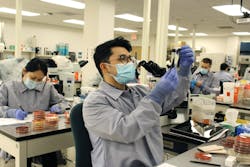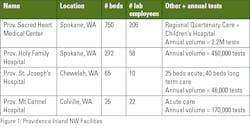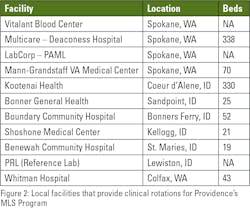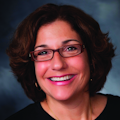Providence Sacred Heart Medical Center and Children’s Hospital (PSHMC) offers something relatively rare: a hospital-based training program in medical laboratory science (MLS).
Launched in 1932, the program is a key recruiting tool for the hospital, as well as for its parent health system, Providence, a 52-hospital Catholic organization operating in Washington, Oregon, Montana, Alaska, Texas, New Mexico, and California.
The 12-month, full-time accredited program, designed for students with a bachelor’s degree, includes eight months of lecture and work in the student lab followed by four months of clinical rotations. The hospital starts cohorts of students in July and January.
“It’s super intensive for them. They’re on campus for forty hours and then go home and study one to two hours a night,” explained Laurianne Mullinax, MS, MLS(ASCP)CM, Senior Manager of Laboratory Medical Education at Providence Inland Northwest.
The program qualifies graduates to take a national certification exam in MLS. It is one of three MLS programs in Washington. There also are three programs to train medical laboratory technicians. Universities and colleges run the other five programs.1
On a national level, slightly less than 100 hospital-based programs for medical laboratory scientists are accredited or approved by the National Accrediting Agency for Clinical Laboratory Sciences (NAACLS).2 Sacred Heart Medical Center is one of those NAACLS-accredited programs.
Those programs are critical because the lab industry struggles to find enough employees to fill all shifts. In its 2020 survey report on staffing, the American Society for Clinical Pathology (ASCP) found that the national vacancy rate for positions in the lab varied from a high of 12.7% for chemistry/toxicology to a low of 3.9% for cytology. 3
Vacancy rates also are impacted by retirements. The ASCP study found that retirement rates ranged from 6% in flow cytometry to 20.4% in chemistry/toxicology. The retirement rate was 16.3% in the core lab and 14.3% in microbiology.
Growing demand
Demand is expected to grow. The Bureau of Labor Statistics said the employment opportunities for clinical laboratory technologists (synonymous with MLS) and technicians will grow 11% from 2020 to 2030, or a total of 36,500 positions.4
In Washington, the three MLS programs graduate about 70 students annually, which is not nearly enough to meet demand in the state, according to Mullinax. Another 50 students graduate from the MLT programs annually, she added.
That is why Sacred Heart launched a second annual cohort of students in 2021. “We’ve been able to almost double the number of students that we are graduating. So originally, on average, for the last few years, we’ve been graduating about 12 students a year with a single cohort, and now in 2021 we graduated 20, and we are on track in 2022 to graduate 22 students,” Mullinax said. “We are unique as a hospital-based program because of the number of students we train annually. Traditionally, hospital-based programs only graduate 3-6 students a year.”
The curriculum covers clinical chemistry, immunology, hematology/coagulation, immunohematology, medical microbiology, urinalysis/body fluids, molecular diagnostics, clinical research, phlebotomy, and laboratory management and practice.
In addition to the 12-month program, the hospital also offers an 18-month hybrid program. In that option, the first 16 weeks are full time in the classroom and student lab while the remainder of the instruction is part time. The clinical rotations also are full time.
In a third option, students enrolled at Eastern Washington University complete their last year of college in the hospital’s full-time MLS program.
Providence typically recruits about 60% of the program’s graduates, and most of those new employees choose one of four hospitals in Eastern Washington, or what Providence refers to as the Inland Northwest region. (Figure 1)
However, some graduates have joined the staff of Providence’s hospitals located in the Seattle region. Those students typically grew up on the western side of the state and want to return home. To facilitate their recruitment after graduation, Sacred Heart will place them in clinical rotations in Providence’s Seattle-area hospitals. “We’ve been able to retain more graduates that way,” explains Mullinax, adding that she also would like to place students in clinical rotations in Providence’s hospitals located outside of Washington for the same reason.
Another strategy Providence uses to recruit graduates of the program is to offer a bonus to reimburse students for a portion of the program’s $15,000 tuition in exchange for a commitment to work at Providence for a specified amount of time.
Because it is not a university-based program, the students of Providence’s program do not have access to federal loan programs, so the extra cash is welcome. “ She notes that the students often are paying all education costs themselves.
Program’s operating challenges
Still, operating the training program is challenging. First, it is expensive. In addition to Mullinax, there are two other full-time employees dedicated to the program and four instructors whose job responsibilities include teaching plus other lab duties.
There are also supply costs and the intrinsic value of the dedicated student lab space. “Hospital space is always at a premium,” she notes. To help manage supply costs, she said, the student lab often uses items that are no longer suitable for processing specimens from real patients, such as nearly expired controls, but are fine for training purposes, she says.
“Hospital-based programs used to be more popular but in the nineties, quite a few programs closed, and that was fine at that point in time because we had enough staff. But they haven’t reopened because they’re so expensive to run,” Mullinax said.
Money aside, another challenge is finding clinical rotations for the students because hosting a student through a rotation in a lab department is time intensive. (Figure 2) It is a big ask for labs that are already struggling to complete daily testing commitments. Fortunately, the program has found labs from both Providence and other organizations to provide clinical rotations. The hospital’s blood banking partner, Vitalant, provides both clinical rotations and instructors for the program. Numerous hospitals in Northwest Idaho also provide clinical rotations.
Other lab specialties trained
In addition to MLS training, Sacred Heart also operates clinical training programs for phlebotomists (4-week and 8-week courses) and histotechnicians (2 or 3 semesters) through a partnership with the University of North Dakota.
In addition, Sacred Heart’s lab education program also provides ongoing continuing education programs for lab employees at the four hospitals in Providence’s Inland Northwest region.
Collaborating with other organizations
Even with Providence’s commitment to training, particularly for new laboratorians, the organization cannot keep up with demand. It is not alone. That is why Mullinax and the other five directors of the training programs in Washington have started meeting regularly to compare notes and solve problems.
“I’m trying to really collaborate, so we can produce as many graduates as possible for our state,” she said. For example, the directors have discussed how to operate remotely during a pandemic and still support hands-on clinical training, or how to increase the number of clinical rotations available for students, given shortages of personnel in most laboratories.
“The health of these programs is so important,” Mullinax concluded.
References
- Washington State Department of Health. Clinical Laboratory Science Professions and Training. https://doh.wa.gov/sites/default/files/legacy/Documents/Pubs//681019.pdf. Revised February 2019. Accessed February 28, 2022.
- NAACLS Directory of Award Lengths and Outstanding Citations. National Accrediting Agency for Clinical Laboratory Science (NAACLS). https://naacls.org/NAACLS/media/Documents/Directory.pdf. Revised April 25, 2019. Accessed February 28, 2022.
- Garcia E, Kundu I, Kelly M, Soles R. The American Society for Clinical Pathology 2020 Vacancy Survey of Medical Laboratories in the United States. Am J Clin Pathol. 2021 Dec 1;aqab197. doi: 10.1093/ajcp/aqab197.
- U.S. Bureau of Labor Statistics. Clinical laboratory technologists and technicians. https://www.bls.gov/ooh/healthcare/clinical-laboratory-technologists-and-technicians.htm#:~:text=in%20May%202020.-,Job%20Outlook,on%20average%2C%20over%20the%20decad. Modified September 8, 2021. Accessed February 28, 2022.
Linda Wilson
Senior Editor



